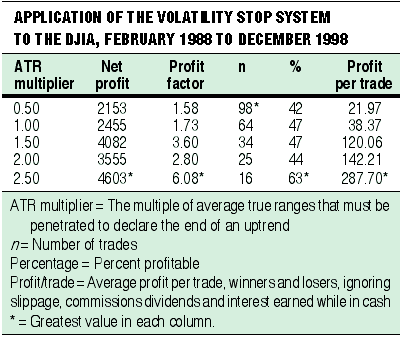SYSTEM DESIGN
The Volatility Stop System
by Mark Vakkur, M.D.
Here's a step-by-step through the development of a robust trading system for capturing major market moves.
Volatility systems have a long and honored history in technical trading. Here, I'll show you a simple, robust version you can use on a weekly basis. I include code in a sidebar and show the results of optimizing the system for the Dow Jones Industrial Average (DJIA), some stocks, and some mutual funds. The results are good across the board.

FIGURE 1: In buying, you pay cash for the right to exercise the option.The most robust systems adapt themselves to the market or security being traded. One indicator particularly well suited to the intermediate-term trader or investor is what I refer to as the volatility stop. The volatility stop is based on the idea that a trading stop should be adjusted for an asset's volatility, here measured as the average true range. (For more on true range, see the sidebar.)
THE VOLATILITY STOP
If I'm going long, the volatility stop is constructed by starting with the entry bar's close and subtracting a multiple of average true range. I use a four-week averaging period and vary the number of multiples of average true range to subtract when I'm optimizing the system. Mathematically, the volatility stop is expressed as:
Volatility_Stop = Close - (average true range of past four weeks) (# true ranges to subtract from the close)
The greater the number of true ranges, the wider your stop, and the more willing you are to let prices swing before declaring a change in trend.
An additional necessary modification is that the volatility stop cannot go down, only up or sideways, unless penetrated by the bar's low. For details, see sidebar "Programming and plotting in TradeStation," in which I show the results of optimizing the system for the Dow Jones Industrial Average (DJIA), some stocks, and some mutual funds.
If you are going short, construct a volatility buy-stop using a multiple of average true ranges above the close. Simply add to the close the product of average true range multiplied by the number of ranges. This indicator must not go up unless penetrated by the last bar's high, at which point you'd be stopped out. Here, however, I will only use the volatility sell-stop, weekly bars, and a four-week lookback period. The same principles apply in any time frame.
THE SYSTEM
I combine the volatility sell-stop with a simple breakout buy-stop and a moving average filter, long only. The entry is: if this week's close is greater than the 12-week exponential moving average of the closes, then buy at this week's high plus one tick on a stop. The moving average filter is a crude screen of intermediate- to long-term trend to avoid entering the market during a sustained downtrend.
Exit the long position at the volatility stop on a stop. And that's it. The system is designed to catch any trends and eventually get out on a stop that constantly adjusts for the actual volatility of the trading vehicle.
Mark Vakkur is a psychiatrist and a stock trader. He can be reached via E-mail at mvakkur@hotmail.com, or via https://www.members.xoom.com/mvakkur.
Excerpted from an article originally published in the October 1999 issue of Technical Analysis of STOCKS & COMMODITIES magazine. All rights reserved. © Copyright 1999, Technical Analysis, Inc.
Return to October 1999 Contents